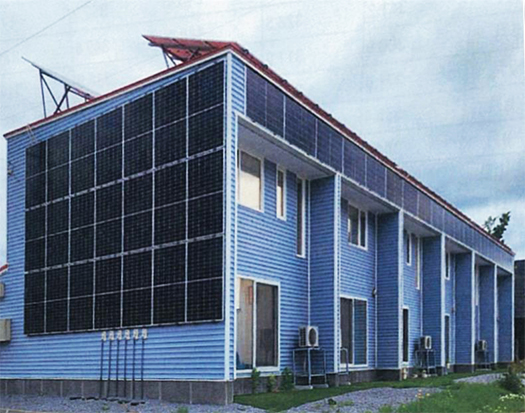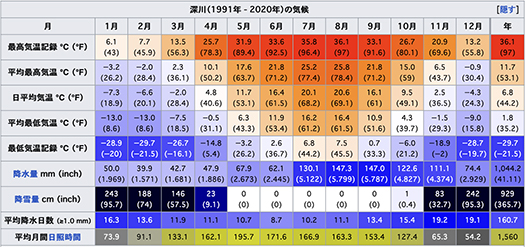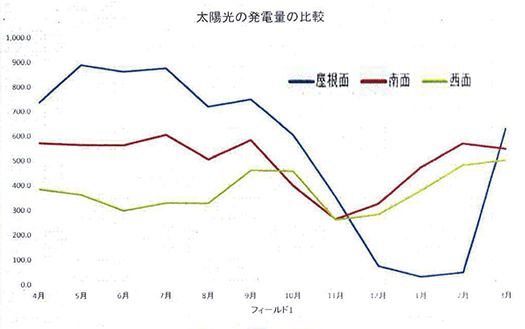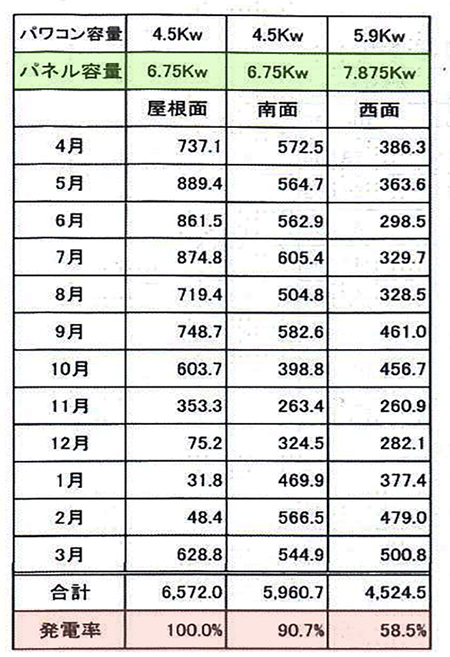

さて先日6/24新住協北海道・旭川例会での発表から。メゾネットタイプの6戸入居の賃貸アパート・総延べ床面積499.85㎡(151坪ほど)への太陽光発電設置・ランニングの実測値が発表されていた。
建物の性能としては0.17-0.2のUa値(外皮平均熱貫流率)。外壁に面した住戸が0.2で中間戸が0.17という性能レベル。
建設地の北海道・深川市は省エネ基準の地域区分では2地域だけれど、限りなく1地域に近い条件ではないかと思われる。年最低気温は零下21.5度。年間降雪量は929cm。近隣の1地域の代表都市・旭川が年最低気温零下41.0度、年間降雪量は557cmというのと比較すると寒さは厳しくはないけれど、降雪ははるかに多い多雪地域。ということでむしろ太陽光発電には不向き。という地域特性。
地域工務店として高断熱高気密住宅に取り組んでいる森栄建設さんが建設し、その後の実績値を測定し続けた事例です。北海道は太陽光発電にとって条件が非常にキビシイ地域ですが、そのなかでも多雪ということではほぼ最悪の条件の地域ということになると思われます。
そういう気候条件下で設置した太陽光発電は屋根面6.75Kwで、当然冬期間は積雪で発電できないので壁面にも設置しています。南面6.75Kw、西面7.875Kwで合計は21.375Kw。外観写真は西面側から南面を見た視野になります。密集地域ではないので日射取得条件としては日影の影響は少ない。


上の図が実測データのグラフと表になります。屋根面は12月から2月までほぼ発電せず、3月からは急回復する。一方で壁面設置では冬期間でもそこそこの発電効率を示している。発電率の指標では、屋根面の100%に対して南面設置で90.7%、西面設置で58.5%。トータルとしてはZEHを達成している事例となっていました。
先述したように北海道地域は太陽光発電に非常に慎重な地域心理を持っている。積雪条件から屋根面設置では冬場の3ヶ月は発電せず、積雪荷重に対する対処にもっとも腐心する地域の住宅の作り手にとって、その屋根の建築条件でそれをさらに複雑化する機器の設置によるトラブルは基本的に避けたいところ。
まことに「課題の最先端地域」たる由縁と言えるでしょう。そういった地域性の中であえてこうした取り組みを行ったフロンティア精神には拍手を送りたい。
新住協・鎌田先生からも「非常に貴重なデータとして新住協としても解析したい」という発言がありました。積雪寒冷地での太陽光発電のひとつの先行事例として研究が進められて、より合理的な判断基準が確立していくことを期待したいと思います。
English version⬇
Annual Measured Data of Solar Power Generation in Fukagawa, Hokkaido (2 energy-saving regions)
Fukagawa City is at the forefront of the challenge, and has the heaviest snowfall climate in Hokkaido. The frontier challenge is to further improve the performance of facilities based on the wealth of insulation experience and knowledge. The frontier challenge to the equipment performance.
Now from the presentation at the recent 6/24 Shinjyukyo Hokkaido/Asahikawa meeting. The presentation was on the actual measured values of the installation and running of a photovoltaic power generation system in a maisonette-type rental apartment with six units and a total floor area of 499.85 m2 (about 151 tsubo).
As for the performance of the building, the Ua value (average thermal transmittance coefficient of the outer skin) of 0.17-0.2. The performance level is 0.2 for units facing the exterior wall and 0.17 for intermediate units.
Fukagawa City in Hokkaido, where the house was built, is classified as an area 2 under the energy conservation standard, but the conditions seem to be as close to area 1 as possible. The annual minimum temperature is 21.5 degrees below zero. Compared to Asahikawa, a representative city of one region, where the annual minimum temperature is 41.0 degrees below zero and the annual snowfall is 557 cm, it is not as cold, but the snowfall is much heavier. This makes the area unsuitable for solar power generation. The area’s characteristics are such that it is not suitable for solar power generation.
This is a case where Moriei Construction, a local construction company working on highly insulated and airtight housing, built the house and continued to measure the actual performance afterwards. Hokkaido is a region with extremely harsh conditions for solar power generation, and it is considered to be one of the worst regions in terms of heavy snowfall.
The photovoltaic power generation system installed in such climatic conditions is 6.75Kw on the roof surface, and of course, it is also installed on the wall surface during winter because it cannot generate power due to snow accumulation. The exterior photo shows the view from the west side looking south. It is not a densely populated area, so the shadow effect is minimal in terms of solar radiation acquisition conditions.
The figure above is a graph and table of actual measured data. Roof surfaces generate almost no electricity from December to February, and then recover rapidly from March. On the other hand, the wall installation shows a modest power generation efficiency even during the winter period. In terms of the power generation rate index, 90.7% for the south side installation and 58.5% for the west side installation compared to 100% for the roof side. In total, this was an example of achieving ZEH.
As mentioned earlier, the Hokkaido region has a very cautious community mentality toward solar power generation. Due to snow conditions, roof-mounted solar power generation systems do not generate electricity for three months in winter, and home builders in this region are most concerned about dealing with snow loads, and basically want to avoid problems caused by installing equipment that would further complicate these conditions.
This is the very reason why the region is “at the forefront of issues. I applaud the frontier spirit that dared to take this approach in such a region.
Dr. Kamata of the New JCMA also commented that the data would be very valuable for the New JCMA to analyze. As a leading example of solar power generation in snowy and cold regions, we hope that the research will continue and that more rational criteria will be established.
Posted on 7月 7th, 2023 by 三木 奎吾
Filed under: 住宅性能・設備







コメントを投稿
「※誹謗中傷や、悪意のある書き込み、営利目的などのコメントを防ぐために、投稿された全てのコメントは一時的に保留されますのでご了承ください。」
You must be logged in to post a comment.